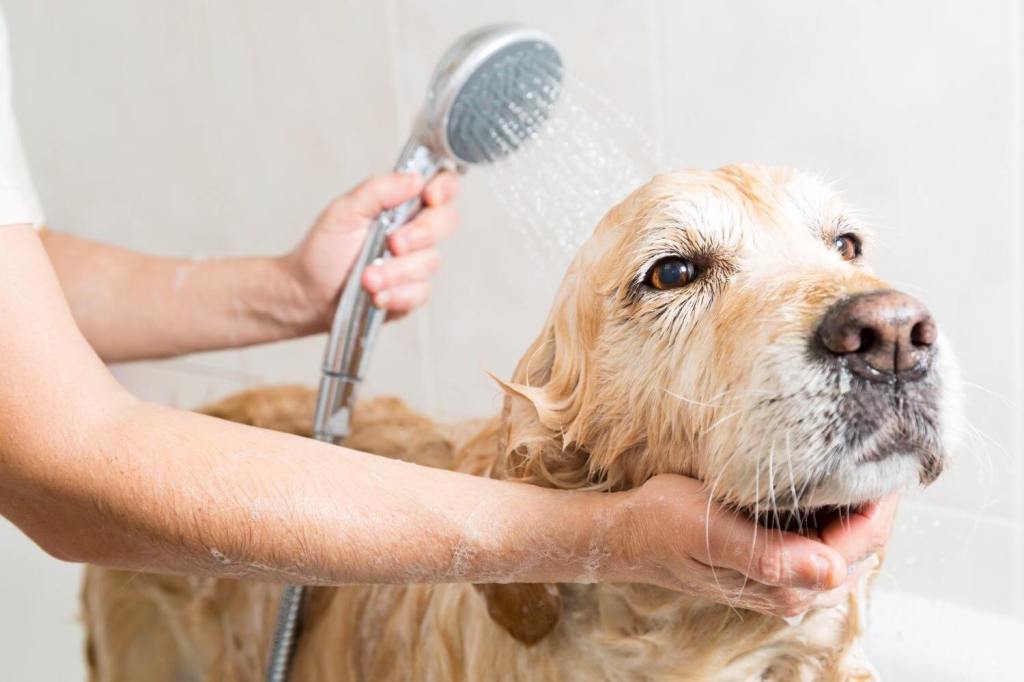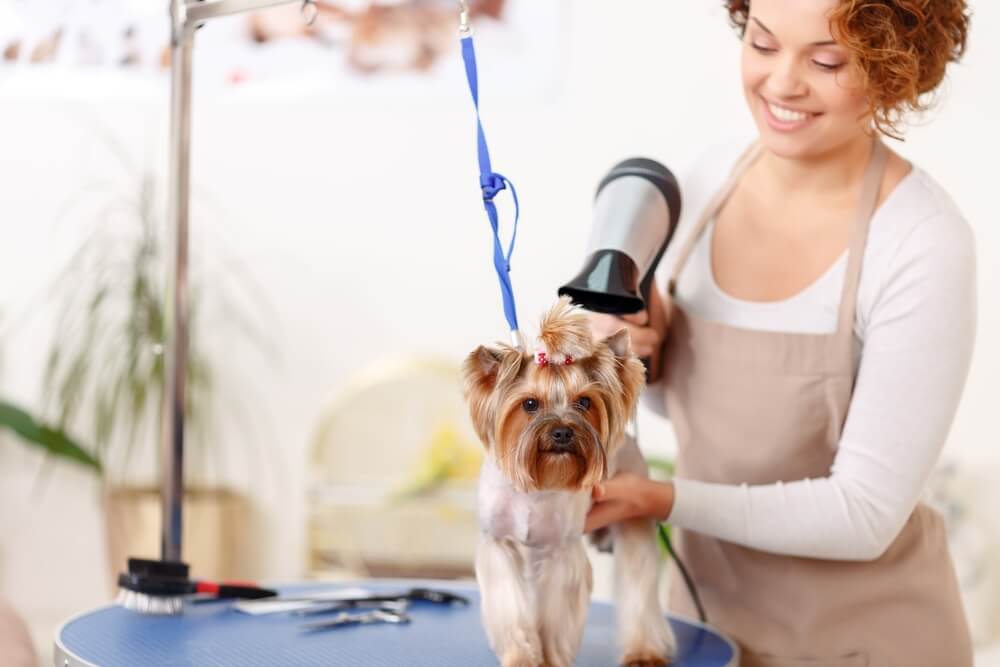Did you know there were 11 million dogs owned in the UK in 2023? Someone needs to clean their muddy paws and keep their coats in tip top condition.
There’s a lot to think about when setting up a dog grooming business, from training and qualifications to business plans and budgeting. Follow our eight steps to become a successful dog groomer:
- Get to know the industry
- Weigh up the pros and cons
- Choose a qualification
- Decide on your niche
- Create your business plan and budget
- Consider business insurance
- Check legal requirements
- Buy professional dog grooming equipment
How to become a dog groomer
Dog groomers do exactly what it says on the tin. More specifically, this means bathing, brushing, and drying dogs, keeping their fur trimmed and their claws clipped.
They also give owners advice on grooming, diet, and coat care.
To become a professional dog groomer you’ll need a real love of animals, patience, and a calm temperament – you may need to calm nervous or unpredictable dogs.
You’ll also need good communication skills to deal with owners (your human clients) day to day, as well as creativity and business savvy to sell your service and build your customer base. What is it that makes pet owners want to spend money on their pets? How do you tap into that emotional desire?
Here’s how you can learn these skills and launch your own dog grooming business.
Step 1. Get to know the industry
The best way to build your dog grooming CV is to volunteer at a kennel or become an apprentice at an established salon. Be prepared to be flexible as you get to know every aspect of running a salon, from understanding the behaviour of different breeds and their nutritional needs, to knowing which specific health problems to watch out for. With experience you can then consider going self-employed.
Step 2. Weigh up the pros and cons
Make sure that you’re fully committed to your business idea. You might love the idea of being around dogs all day, but are you prepared for the physical demands of the job? You’ll be on your feet all day, often dealing with stressed out dogs and demanding owners. Speak to some experienced dog groomers to make sure you’re fully aware of what the job entails.

Step 3. Choose a qualification
Dog groomer qualifications aren’t essential, but completing a course related to animal care and maintenance can help you stand out to potential clients and employers.
There are a number of training routes available – college courses, apprenticeships, and specialist courses run by private organisations. How long it takes to become a dog groomer will depend on which you take.
These City & Guilds dog groomer training courses are offered at colleges and centres across the country:
- Level 2 Certificate for Dog Grooming Assistants
- Level 3 Certificate in Introductory Dog Grooming
- Level 3 Certificate/Diploma for Dog Grooming Stylists
You could complete a Dog Grooming Level 2 Apprenticeship, or even an Animal Care and Welfare Manager Level 3 Advanced Apprenticeship to help with supervising or managing other staff or your wider business.
Finally, the National Pet College has accredited some organisations to deliver professional training privately.
Step 4. Decide on your niche
You’ll need to identify what makes your business unique so you can stand out in a competitive market. Are you going to specialise in grooming small dogs or long haired dogs? Will you focus on running a sustainable business with eco-friendly products?
Do your research and start marketing to potential clients.
Step 5. Create a business plan and budget
It’s important to write your dog grooming business plan so you know how your business will be structured and marketed – but also how you expect it to grow.
It’s also useful to conduct competitor analysis to better understand the landscape you’re working in and how you can offer something different, better, or new compared to similar businesses in your area. You could even try visiting a few of your competitors as a customer if you or a friend has a dog.
You’ll also need to consider setup costs and budget accordingly. The cost of setting up your business will vary depending on whether you’re going to run a mobile salon, lease a commercial property, or work from home. Make sure you factor in rent and vehicle costs (where relevant) as well as the cost of your equipment.
Step 6. Consider business insurance
Running a dog grooming business involves caring for people’s pets, which means they expect you to operate in a professional and careful way.
Getting a tailored pet grooming insurance policy can protect you, your premises, and the dogs in your care, should something go wrong.
Step 7. Check legal requirements
You don’t need a dog groomer licence for your business in the UK. However, you should be aware of the following legislation:
- Animal Welfare Act 2006 – you have a duty of care to people’s pets so you must follow good practice, which includes providing the right environment and nutrition, and protecting dogs from pain or injury
- Copyright, Designs & Patents Act 1988 – if you’re planning to play music in your salon, make sure you organise a licence from PPL PRS
- Control of Substances Hazardous to Health (COSHH) – when using potentially harmful chemicals, for example shampoos and cleaning products, make sure you know how to keep yourself and your employees safe by using the correct protective equipment
Step 8. Buy professional dog grooming equipment
Generally speaking, dog groomers will use the equipment listed below.
Grooming essentials
- grooming table
- clippers
- scissors
- dematting comb
- brushes
- nail clippers (various sizes)
Bathing and pampering
- bath
- dryer
- shampoo
- conditioner
- flea shampoo
- towels
Step 9. Set yourself up as a self-employed dog groomer
Everyone who’s self-employed must be registered with HMRC so you can declare your earnings and pay the correct tax. Unsure how to register and why? Our guide on setting yourself up as self-employed will help get you up to speed on the admin side of running your own business.
How much do dog groomers make in the UK?
As a starting salary, dog groomers typically earn £13,000, and with experience this can rise to £20,000, according to the National Careers Service.
The good thing is, once you’re a self-employed dog groomer you can set your own prices. The UK average for a grooming session is now around £43.
The amount you charge will usually vary, depending on the size of the dog, condition of its coat, its temperament, and where your business is based.
Similar careers in the pet industry
There’s a range of careers in the pet industry for those who want to work with different animals. You could also consider becoming a:
- dog walker
- cattery owner
- pet minder (anything from cats and dogs to birds and horses)
Are you looking to start a dog grooming business? Let us know your progress in the comments below or tag us in your photos on social media.
Other small business guides:
- UK business ideas for 2024 – top 10 trends to watch
- How to start your own business: a 9-step guide
- Self-assessment and tax resources
- 7 of the best business loans compared
Insure your dog grooming business
With Simply Business you can build a single self employed insurance policy combining the covers that are relevant to you. Whether it’s public liability insurance, professional indemnity or whatever else you need, we’ll run you a quick quote online, and let you decide if we’re a good fit.
